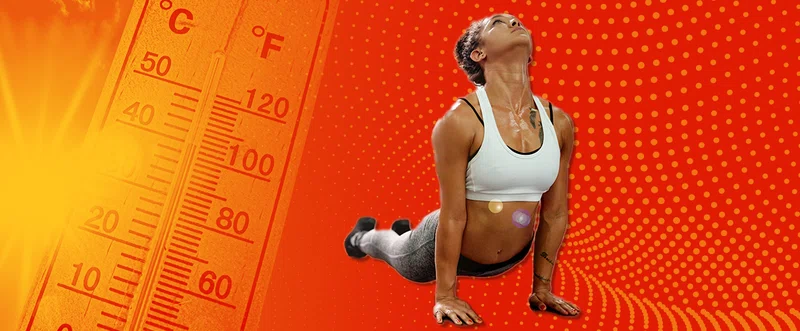


Outcomes Research
Practicing Bikram “hot” yoga does not significantly increase yoga’s health benefits

In recent years, hot yoga, or Bikram yoga, has been a popular form of exercise. The practice, which is done in a room heated to temperatures upward of 105 degrees F, is thought to increase flexibility and general fitness, reduce inflammation and blood pressure, increase muscular strength and improve mood, among other things.
A study conducted by researchers at the Houston Methodist Department of Orthopedics and Sports Medicine, investigated these claims.
Investigators gathered a cohort of 16 participants, mostly women, who were experienced yoga practitioners in order to compare a session of hot yoga with a session of room temperature yoga to see if the claims of improved range of movement, oxygen consumption, caloric expenditure and biomarkers of acute stress and inflammation were markedly different after a one-hour session.
Heated conditions have been shown to increase heart rate, oxygen and perceived stress during steady aerobic exercise. These conditions also have been known to increase substrate oxidation in adults who are untrained, increasing their metabolism. Hot yoga also is purported to improve flexibility as heat applied to muscles has been observed to influence range of motion. The key question investigators tried to answer in this study was whether hot yoga reaches the level of intensity needed to influence each of these claims beyond practicing yoga at room temperature.
Investigators’ research showed there is little evidence to support these claims.

The data from this study revealed that hot yoga is safe for those with no known contraindications; however, the practice does not sufficiently stand up to the claims that hot yoga is better for you. It is possible that the heated environment might increase fat loss and have a favorable effect on metabolic changes over time. Despite the fact that hot yoga may make you feel like you had a good workout, neither group had a significant aerobic workload- so it is not a substitute for your cardio. Further research into how this practice might be incorporated into a comprehensive fitness routine should be studied.

Patrick McCulloch, MD
John S. Dunn Chair in Orthopedic Surgery
Associate Professor of Clinical Orthopedic Surgery
Houston Methodist
All study participants had practiced yoga for more than two years and were familiar with the poses examined in the study. The study sessions were conducted following specific physical activity and dietary regimens to control these variables. The participants completed a one-hour session of standardized yoga in Bikram sequences and synced to an instructional video in both heated and room temperature conditions on separate visits separated by 96 hours.
Participants’ blood pressure was taken before and after the sessions and heart rate and caloric expenditures were monitored during yoga bouts for a period of about five minutes. Passive range of motion was assessed in the upper body and lower body before and immediately after each session. Blood samples were taken immediately before and 30-minutes after both sessions were completed to detect serum cytokine changes.
The study subjects tolerated all sessions well. There were no differences detected between conditions in either hot yoga or room temperature yoga to heart rate or gas exchange regarding samples taken during the pre-exercise collection period.
Investigators observed the respiratory exchange ratio was reduced during the hot yoga sessions compared to the room temperature sessions, resulting in significant reductions in carbohydrate oxidation and an increase in fat oxidation.
Investigators found that neither hot room nor room temperature yoga achieved the VO2 or caloric thresholds for improving physical fitness or producing chronic improvements to body composition. Results did find an increase in fat metabolism indicated by measurements in gas exchange and acute alterations in Interleukin 6. Hot yoga was found to promote greater range of motion for only one of 13 measures – hip abduction.

Patrick C. McCulloch, MD, John S. Dunn Chair in Orthopedic Surgery and associate professor of clinical orthopedic surgery
Bradley S. Lambert, Katherine E. Miller, Domenica A. Delgado, Kalyan Chaliki, Joshua Lee, Guillermo Bauza, Francesca Taraballi, David Dong, Ennio Tasciotti, Joshua D. Harris, and Patrick C. McCulloch. International Journal of Exercise Science 13(3): 802-817, 2020. https://pubmed.ncbi.nlm.nih.gov/32509120/
Overall, investigators found no statistical difference between the two forms in terms of oxygen consumption or caloric expenditure – a difference from other forms of exercise performed at higher intensities. Investigators believe the low-intensity nature of the particular yoga session used was insufficient to drive a thermoregulatory response strong enough to influence caloric expenditure.
The American College of Sports Medicine recommends that to improve aerobic fitness, adults should exercise at an intensity of more than 40-50 percent of VO2max for at least 30 minutes per session. Those wishing to improve body composition or lose weight should burn 300-400 kcals per session. This investigation found participants expended an average of 151 ± 4 kcals per room temperature session and 156 ± 7 kcals per hot yoga session. A steady state aerobic exercise at 50 percent VO2max, considered low to moderate intensity, in this present participant population would have yielded an average of 317 ± 19 kcals across the same timeline.
Investigators believe despite the limitations, it is possible this type of exercise is beneficial to those seeking low-impact, low-intensity workouts. They believe it is possible yoga might be an effective way for those who are inactive to get back into a workout routine and encourage more study to learn about whether consistent hot yoga practices contribute to greater metabolic function and which segments of society could possibly benefit from that.
Erin Graham, May 2021
Related Articles
A Learning Healthcare System Takes on COVID-19
CURATOR offers an informatics driven approach to evidence synthesis







